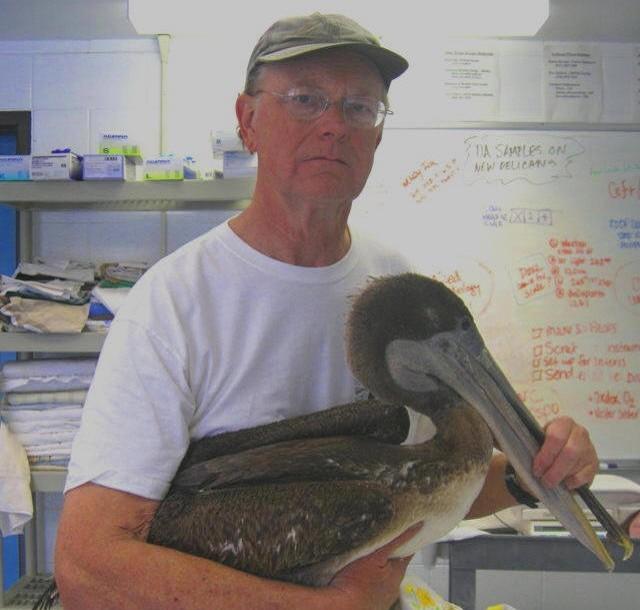
Our ~150,000 California brown pelicans breed in spring and early summer in northwest Mexico and at the U.S. Channel Islands off of Ventura. After fledging, groups of young birds disperse to the Salton Sea and north along the California, Oregon and Washington coasts. Even in a good year with plenty of forage fish, as many as 60% of fledglings do not survive to breeding age. Yet pelicans would appear to be adapted to these early life stage losses-- with a fossil record extending back about 15 million years, this is a species built to last.
This resilience surely helped brown pelicans recover from dangerously low population levels in the 1960’s, caused by decades of impacts from chemicals, habitat destruction and disturbance. All six subspecies were listed as endangered in the U.S. and Mexico and the species responded to actions in the Recovery Plan. By 2009, the last subspecies- our California pelican- was triumphantly removed from the endangered list by the U.S. Fish & Wildlife Service and declared recovered. This was the right decision. However, soon after delisting, California brown pelican nest success in both the U.S. and Mexico plummeted or ceased entirely for multiple years, alarming biologists. The primary driver of these reproductive failures in the U.S. are reduced stocks of forage fish due to climate change impacts, and in Mexico they are climate change impacts as well as over-exploitative commercial fisheries.
While pelicans are hardy and adapted to periodic poor ocean conditions, what worries agency and Audubon biologists is the pulse of red flags in the brown pelican population over the past 10 years. This has included multiple years of skipped breeding or poor breeding success; significant die-offs of adult pelicans and large pulses of starving young pelicans; and unusual behaviors such as pelicans shaking common murres seeking regurgitated fish, and pelicans eating the young of other seabirds. Protracted, chronic lack of forage fish in the environment leads to these behaviors and eventually drives down populations.
When a bird species is in trouble, a key step is to ensure adequate monitoring to understand its ongoing status and its response to conservation actions. When Audubon learned in 2012 that federal agencies no longer planned to continue monitoring pelican nesting at the Channel Islands, we teamed up with the Center for Biological Diversity, and and the Audubon network to successfully pressure the agencies to re-commit to this monitoring. We also raised funds from eight chapters in southern and central California – San Fernando Valley, Buena Vista, Pasadena, San Diego, Sea and Sage, Santa Barbara, Ventura, and Morro Coast – to ensure there were no lapses in nest monitoring until agency resources could be put into place. The outcome we achieved together is an uninterrupted data set showing a close relationship of nest success with the abundance of forage fish, particularly anchovy and sardine.
Now that we are confident the Channel Islands National Park and the U.S. Fish and Wildlife Service will continue to track nest success at the Channel Islands, we are focusing on helping brown pelicans in four ways. First, we are fighting hard alongside Pew Trusts, Sea and Sage Audubon, San Diego Audubon and a handful of other west coast partners to bring management of the most important food for brown pelicans- northern anchovy - into compliance with our federal fisheries management framework. With our advocacy, federal fisheries managers went from ignoring anchovy, with a “set it and forget it” harvest quota, to acknowledging anchovy must be actively managed to ensure catch levels are sustainable and that local depletion does not occur. We will continue to work on this effort until these objectives are achieved, which we expect to occur in the next 2-3 years. Audubon Activists have been an essential voice in this effort and we will continue to ask for your participation in this regard.
Second, we have started to fight Congressional attacks on the Magnuson Stevens Act (“MSA”). The MSA is our effective, hard-working national legal framework for protecting commercial and recreational fish, and seabird forage fish such as anchovy. Third, we collaborate with the U.S. Fish and Wildlife Service and numerous Audubon coastal chapters in the West Coast Brown Pelican Survey. This biannual survey tracks the abundance and age distribution of brown pelicans, providing valuable insight into the health of the population. Finally, we are working to understand and reduce the impacts of climate change to the birds and the oceans through our state and national efforts to reduce greenhouse gas emissions and promote renewable energy sources.
Brown pelicans have prevailed through tough times before. With the support of people like you and the entire Audubon network, pelicans can thrive into the future.
By Anna Weinstein
Monthly Giving
Our monthly giving program offers the peace of mind that you’re doing your part every day.




